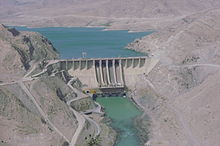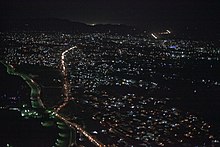Renewable energy in Afghanistan
This article may need to be rewritten to comply with Wikipedia's quality standards. (April 2021) |



Renewable energy in Afghanistan includes biomass, hydropower, solar, and wind power.[1][2][3][4][5] Afghanistan is a landlocked country surrounded by five other countries. With a population of less than 35 million people, it is one of the lowest energy consuming countries in relation to a global standing.[6] It holds a spot as one of the countries with a smaller ecological footprint. Hydropower is currently the main source of renewable energy due to Afghanistan's geographical location. Its large mountainous environment facilitates the siting of hydroelectric dams (see also list of dams and reservoirs in Afghanistan) and other facets of hydro energy.[2]
The renewable energy resource potential of Afghanistan is estimated at over 300,000 MW according to the state's Ministry of Energy and Water.[7][2] The country currently spends around $280 million on importing 670 MW of electricity from neighboring Iran, Uzbekistan, Tajikistan and Turkmenistan.[8][1]
Another form of renewable energy in Afghanistan is biogas.[9] With the start of biogas, communities have begun to feel the benefits beyond that of the environment through capacity building as well.[9]
Solar and wind power[]
It was reported that Afghanistan has the potential to produce over 222,000 MW of electricity by using solar panels.[2][7] The use of solar power is steadily increasing throughout country.[10][11][5][4] [12][3][13][14] Annual average solar insolation varies from 4 to 6.5 kWh/m2/day, with over 300 days of sunshine per year.
The report also stated that Afghanistan has the potential to produce over 66,000 MW of electricity by installing and using wind turbines.[7] Wind power is not the commonly used method in Afghanistan for renewable energy though there are vast opportunities. It is believed that the areas which would produce the most wind energy and would benefit the most are in western Afghanistan, and some areas in the country's north as well.[15]
Hydropower[]

It was reported that Afghanistan has the potential to produce over 23,000 MW of hydroelectricity.[7][2][16] The country has significant hydro resources with the river catchment area of 677,900 km2, annual average rainfall of 300 mm and wide spread hilly topography.[6]

Currently there is a 304 MW installed capacity of electricity generated by hydropower, in which 183 MW are in operation. The current system in place though it works well, is not without its flaws. As Yasah et al. contend, "the common strategy is currently to build micro-hydropower facilities to power single bulbs and maybe a water boiler for the whole community. Such constructions will not deliver sufficient power for electric ovens etc., grid electricity will not stretch out to the rural areas of Afghanistan in the near decades."[17] That being said, hydropower and hydro-energy are some of the best options that are currently in place. The geographical location of Afghanistan is extremely mountainous which makes the implementation of hydropower an easier choice.[18] Acknowledging how low Afghanistan's ecological footprint is in terms of its energy consumption, it is not a current possibility to have enough energy.[6] In fact, "the country has 75 billion cubic meters of potentially available renewable water resources are also the main source of recharge for groundwater as precipitation is low in Afghanistan."[18] Water has become such a precious commodity across the globe that makes having an abundance of it, as a natural resource is a fortunate reality for Afghanistan.[18] That being said it is also contended that even though these ideas and proposals for hydro energy would work and have positive effects, the necessary work that is a project such as hydro energy.[18][17]
Biomass energy[]
It is claimed that Afghanistan has the potential to produce about 4,000 MW of power through biomass.[7][2] Traditional biomass energy has supplied up to 90% of energy demand,[19] such as from firewood and dung.[20][9][21]
Biogas[]
Biogas can be used in many different countries with the same function and uses. The renewable energy sector in Afghanistan is growing today through biogas.[9] The "use of biogas produced from anaerobic decomposition of organic material. This biogas typically contains equal amounts of CH4 and CO2."[22] When biogas is converted in the right way, that is when the renewable energy and resource is possible deriving the hydrogen from the waste.[9] Biogas "decompose municipal solid wastes anaerobically and landfill gas to energy projects that directly combust the landfill gas are being implemented."[22] The strength of biogas is incredible, it has been proven that the "biogas energy corridor can work as a good substitute for nearly 70% of the country's population residing in rural areas. Installation of plants to bottle the biogas can be additional opportunity. The need of a national policy is imperative to bring this technology at farmer's doorstep."[23] The renewable energy that this brings is very strong through reducing the carbon footprint of each community immeasurably.[9] The system of biogas also creates immense potential for capacity building through the community connectedness that goes into the process.[22] The teamwork is inevitable that comes from this initiative which begins with an exchange of knowledge, both shared and new. Then capacity building can begin to form contributing to resources and market development growing rapidly.[9] Advocacy for all parties is the only way for effective participatory renewable energy to be made.[24] The United Nations Environment Program (UNEP) spoke on the topic when the Country Program Manager of Afghanistan had this to say,
UNEP is pleased to endorse the vision and mission of the Biogas Consortium Afghanistan. The majority of the population of Afghanistan uses firewood and coal for their cooking and heating needs; more sustainable energy options are required. […] UNEP has committed to providing higher-level guidance, helping the consortium align its activities towards national policies and strategies. UNEP shall also advocate the benefits and studies that arise from the consortiums work in biogas in Afghanistan[24]
See also[]
- Energy in Afghanistan
- Renewable energy by country
- Renewable energy in Asia
References[]
- ^ a b "Da Afghanistan Breshna Sherkat" (PDF). United States Energy Association (USEA). 2014. Retrieved 2019-04-17.
- ^ a b c d e f "The Power of Nature: How Renewable Energy is Changing Lives in Afghanistan". United Nations Development Programme (UNDP). September 13, 2017. Retrieved 2019-04-20.
- ^ a b "Central Asia's Largest Off-grid Solar Power System: Bringing electricity & hope to Afghanistan". North American Clean Energy. November 20, 2014. Retrieved 2019-04-20.
- ^ a b "First-ever solar-wind power plant goes functional in Herat". Pajhwok Afghan News. September 17, 2017. Retrieved 2019-04-02.
- ^ a b "First-ever Kabul solar energy plant goes functional". Pajhwok Afghan News. May 22, 2018. Retrieved 2019-04-01.
- ^ a b c Mainali, Brijesh; Silveira, Semida (September 2013). "Alternative pathways for providing access to electricity in developing countries". Renewable Energy. 57: 299–310. doi:10.1016/j.renene.2013.01.057.
- ^ a b c d e "ADB to provide $44.76m for construction of solar power plant". Pajhwok Afghan News. November 26, 2017. Retrieved 2019-04-18.
- ^ "Afghanistan Annually Pays $280M for Imported Power". TOLOnews. September 1, 2020. Retrieved 2020-10-10.
- ^ a b c d e f g
- UNDP Biogas Systems Turn Manure into Cheap, Clean Power. UNDP. September 21, 2016.
- Biogas technology introduced to Bamyan, Afghanistan. Bremen Overseas Research and Development Association (BORDA). August 28, 2014.
- ^ "Home solar-storage programme targets Afghanistan's 20 million living off-grid". February 20, 2019. Retrieved 2020-10-10.
- ^ "Solar Power Plants To Be Inaugurated In Kabul, Kandahar". TOLOnews. July 9, 2019. Retrieved 2020-10-10.
- ^ "Eastern Provinces To Get Solar Energy Boost". TOLOnews. April 14, 2018. Retrieved 2019-04-02.
- ^ ECOsys Implements the Hybrid Solar and Wind Power Plant in Herat Province-Afghanistan
- ^ Solar powered hatchery in Balkh to increase poultry production
- ^ Elliott, Dennis. "Wind Resource Assessment and Mapping for Afghanistan and Pakistan." South Asia Regional Initiative for Energy Integration. National Renewable Energy Laboratory, June 2007. Web. 30 Jan. 2016.
- ^ "Afghanistan Can Generate 23,000 Megawatts Of Hydroelectric Power". TOLOnews. August 11, 2017. Retrieved 2019-04-20.
- ^ a b Yarash, Nasratullah, Paul Smith, and Katja Mielke. "The Fuel Economy of Mountain Villages in Ishkamish and Burka (Northeast Afghanistan). Rural Subsistence and Urban Marketing Patterns." Working Paper Series 9 (2010): 20-50. Zentrum Für Entwicklungsforschung Center for Development Research. Web. 30 Jan. 2016.
- ^ a b c d Ahmad, Masood, and Mahwash Wasiq. Water Resource Development in Northern Afghanistan and Its Implication for Amu Darya Basin. 36th ed. United States of America: World Bank, 2004. Google Books. Web. 29 Jan. 2016.
- ^ "Assessment of Biomass Resources in Afghanistan" (PDF). United States: www.nrel.gov. January 2011. p. 4. Retrieved 2019-04-02.
- ^ Assessment of Biomass Resources in Afghanistan
- ^ "Afghanistan Sustainable Energy for Rural Development (ASERD)". United Nations Development Programme (UNDP). 2019. Retrieved 2019-04-02.
- ^ a b c Barrai, Frederico, Tracy Jackson, Noah Whitmore, and Marco J. Castaldi. "The Role of Carbon Deposition on Precious Metal Catalyst Activity during Dry Reforming of Biogas." Catalysis Today 129.3-4 (2007): 391-96. Elsevier. Web. 30 Jan. 2016.
- ^ Amjid, Syed, Muhammad Q. Bilal, Muhammad S. Nazir, and Atlaf Hussain. "Biogas, Renewable Energy Resource for Pakistan." Renewable and Sustainable Energy Reviews: 2833-837. Elsevier. 20 Feb. 2011. Web. 29 Jan. 2016.
- ^ a b "BORDA in Afghanistan". Bremen Overseas Research and Development Association. Retrieved 2019-04-20.
External links[]
![]() Media related to Renewable energy in Afghanistan at Wikimedia Commons
Media related to Renewable energy in Afghanistan at Wikimedia Commons
- ADB Supports First Solar Power Plant to Boost Renewabl e Energy in Afghanistan, Asian Development Bank, 26 Nov. 2017.
- Afghanistan and Tajikistan: Regional Power Transmission Interconnection Project, Asian Development Bank, 25 Nov. 2014.
- Renewable energy in Afghanistan
